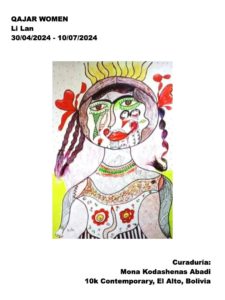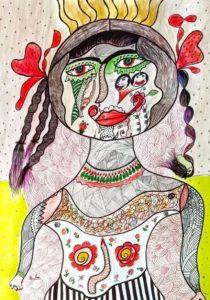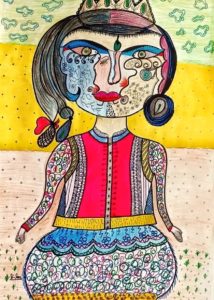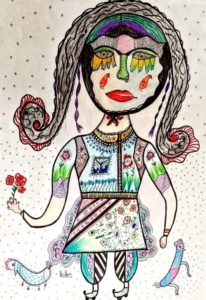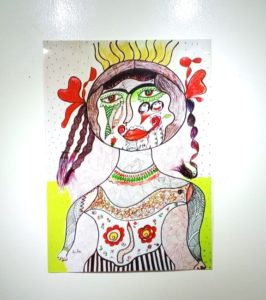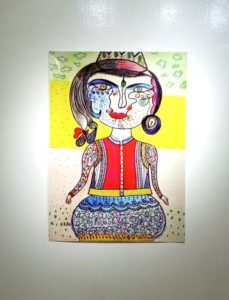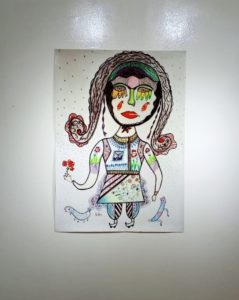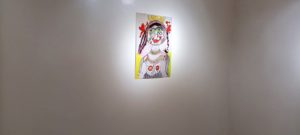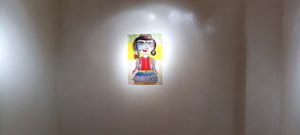Qajar women
Comisaria/curator: Mona Kodashenas Abadi
30 de abril – 10 de julio 2024 / April 30th – July 10th 2024
Texto de sala – Exhibition text
.
La era Qajar marca un período importante en la historia de Irán, particularmente en cuanto al estatus de las mujeres. Mujeres de diversos contextos, incluidas aquellas de la familia real, familias no élite influyentes, comerciantes, académicas y campesinas, estaban en gran medida sujetas a la autoridad de sus familias, con ligeras diferencias en las expectativas entre la élite urbana, las cortesanas y las mujeres comunes. Su influencia permanecía mayormente confinada al ámbito doméstico y al harén, rara vez extendiéndose al mundo exterior.
Según los relatos de viajeros extranjeros que visitaron Irán durante el reinado de Muzaffar al-Din Shah Qajar, las mujeres iraníes eran descritas con un hermoso cabello negro que brillaba como la sombra de la noche. Solían partirse el cabello por la mitad, con cada sección a un lado, y aplicaban aceites aromáticos. Un pequeño mechón, de unos quince centímetros de largo, enmarcaba cada lado de su rostro, conocido como “Toreh” o “Marghule”.
Eugène Flandin, un escritor de viajes francés que visitó Irán durante el reinado de Mohammad Shah Qajar, describió cómo las mujeres iraníes delineaban sus ojos con una sustancia negra llamada “sorme”, aplicada con una varilla afilada, y cómo realzaban su tez con un toque de rojo. Muchas también decoraban sus rostros con lunares artificiales, similar a un lunar en forma de estrella entre las cejas.
Las mujeres pasaban gran parte de su tiempo en los baños públicos, donde teñían su cabello, cejas, las plantas de sus pies y la punta de sus dedos con henna para producir un tono anaranjado. A veces pintaban en su piel diseños elaborados como árboles, animales y estrellas, los cuales quedaban visibles porque su vestimenta normalmente dejaba partes del pecho y el estómago descubiertos.
La historia de las mujeres Qajar en Irán es significativa y ofrece un extenso material para estudios culturales. La artista autodidacta “Li Lan” trae a la vida esta era con sus representaciones notables de los rostros, maquillaje y vestimenta de las mujeres Qajar. Ella explica que el maquillaje y la vestimenta de las mujeres Qajar siempre la han fascinado; cada vez que comienza a esbozar rostros femeninos, se encuentra instintivamente dibujando a mujeres Qajar.
Al describir su trabajo, Li Lan dice:
“Le doy vida a mis lápices. ¿Y qué podría transmitir cómo los pensamientos e ideas cobran vida en el lienzo blanco del papel? Cómo los patrones e imágenes llenan de vida colores, corazones y miradas. Por el poder del pensamiento, la vida sigue siendo hermosa. Y creo que es el amor el que me rodea con los ojos del arte.”
Mona khodashenas Abadi
.
The Qajar era marks an important period in the history of Iran, particularly regarding the status of women. Women from diverse backgrounds—including those from the royal family, influential non-elite families, marketers, scholars, and peasants—were all largely subject to the authority of their family, with subtle differences in expectations between urban elite, courtiers, and commoners. Their influence remained mostly confined to the domestic sphere and harem, rarely extending into the world beyond.
According to foreign travelers who visited Iran during Muzaffar al-Din Shah Qajar’s reign, Iranian women were described as having beautiful black hair that shone like nightshade. They would typically part their hair down the middle, one section on each side, and apply aromatic oils. A small strand, about fifteen centimeters long, would frame each side of their face, known as “Toreh” or “Marghule.”
Eugène Flandin, a French travel writer who visited Iran during Mohammad Shah Qajar’s rule, described how Iranian women would line their eyes with a black substance called “sorme,” applied with a sharp rod, and enhance their complexion with a hint of red. Many women also decorated their faces with artificial moles, resembling a star-like mole between the eyebrows.
Women spent much of their time in public baths, dyeing their hair, eyebrows, the soles of their feet, and fingertips with henna to produce an orange hue. Sometimes, they would paint elaborate designs like trees, animals, and stars on their skin, left visible because their clothing typically left parts of the chest and stomach uncovered.
The history of Qajar women in Iran is significant and offers extensive material for cultural studies. The self-taught artist “Li Lan” brings this era to life with her remarkable depictions of Qajar women’s faces, makeup, and clothing. She explains that the makeup and attire of Qajar women have always fascinated her; whenever she begins to sketch women’s faces, she finds herself instinctively drawing Qajar women.
In describing her work, Li Lan says:
“I breathe life into my pencils. And what could convey how thoughts and ideas come alive on the white canvas of paper? How patterns and images bring colors, hearts, and gazes to life. By the power of thought, life remains beautiful. And I believe that it is love that surrounds me with the eyes of art.”
Mona khodashenas Abadi
